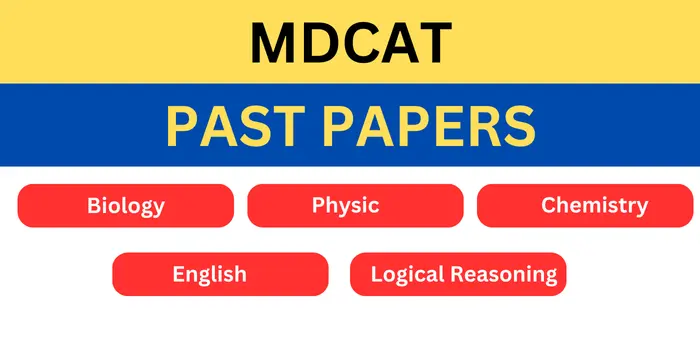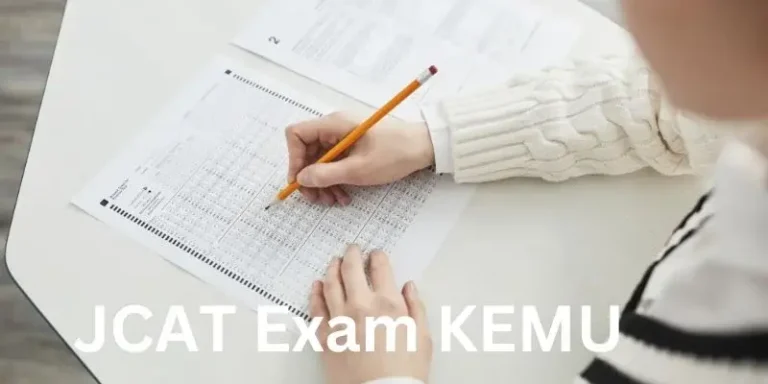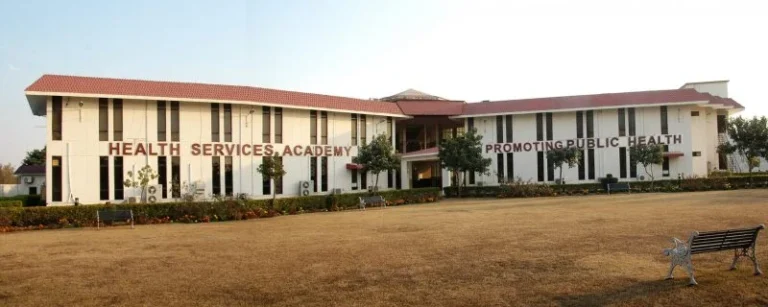PMDC MDCAT Syllabus 2025-2026 [Download PDF]
The PMDC announces that the MDCAT syllabus will remain the same as in previous years. But any way, if there are some changes in the syllabus, you can download the official document and cover all the topics present in the PMDC MDCAT syllabus.
In this article, we are going to cover all the information related to the PMC MDCAT syllabus.
As www.pmdc.pk syllabus 2025 is same as MDCAT syllabus 2024. Given download link for syllabus at the end of article.
For MDCAT exam material, click this link.
Also Read: NUMS MDCAT Syllabus
Check Also: Past Paper Question Answer
The MDCAT syllabus will remain the same each year. This syllabus is also applicable to MDCAT UHS, KMU, SZABIST, and DOW.
The MDCAT exam pattern is in accordance with this syllabus.
MDCAT Syllabus Subject-Wise MCQ Distribution
| Subject | MCQs | Percentage |
|---|---|---|
| Biology | 68 | 34% |
| Physic | 54 | 27% |
| Chemistry | 54 | 27% |
| English | 18 | 9% |
| Logical Reasoning | 6 | 3% |
Content List for Biology | PDMC Syllabus
| Unit No. | Title | Student Learning Outcome |
|---|---|---|
| 1 | Acellular Life | 1.1 Classify viruses on basis of their structure/number of strands/diseases/host etc. |
| 1.2 Identify symptoms, mode of transmission and cause of viral disease (AIDS). | ||
| 2 | Bioenergetics | 2.1 Explain the process of photosynthesis. |
| 2.2 Explain the role of factors (light, water, CO₂) affecting photosynthesis. | ||
| 2.3 Explain light-dependent and independent phases/reactions. | ||
| 3 | Biological Molecules | 3.1 Define and classify biological molecules. |
| 3.2 Discuss the importance of biological molecules. | ||
| 3.3 Describe biologically important properties of water (polarity, hydrolysis, specific heat, water as solvent and reagent, density, cohesion/ionization). | ||
| 3.4 Discuss carbohydrates: monosaccharides (glucose), oligosaccharides (cane sugar, sucrose, lactose), polysaccharides (starch, cellulose, glycogen). | ||
| 3.5 Describe proteins: amino acids, structure of proteins. | ||
| 3.6 Describe lipids: phospholipids, triglycerides, alcohol and esters (acylglycerol). | ||
| 3.7 Give an account of RNA. | ||
| 3.8 Discuss conjugated molecules (glycolipids, glycoproteins). | ||
| 4 | Cell Structure & Function | 4.1 Compare the structure of typical animal and plant cell. |
| 4.2 Compare and contrast the structure of prokaryotic and eukaryotic cells. | ||
| 4.3 Outline the structure and function of nucleus, ER, Golgi apparatus, mitochondria. | ||
| 5 | Coordination & Control | 5.1 Recognize receptors as transducers sensitive to stimuli. |
| 5.2 Define neurons. | ||
| 5.3 Explain structure of neuron (cell body, dendrites, axon, myelin sheath, Schwann cells). | ||
| 5.4 Define nerve impulse. | ||
| 5.5 Define reflexes. | ||
| 5.6 Explain components of a reflex arc. | ||
| 5.7 List brain parts (brainstem, midbrain, cerebellum, cerebrum). | ||
| 5.8 Describe the functions of each brain part. | ||
| 6 | Diversity Among Animals | 6.1 Describe general characteristics of animals. |
| 7 | Enzymes | 7.1 Describe distinguishing characteristics of enzymes. |
| 7.2 Explain mechanism of enzyme action. | ||
| 7.3 Describe effects of temperature, pH, concentration on enzymes. | ||
| 7.4 Describe enzyme inhibitors. | ||
| 8 | Evolution | 8.1 Explain origin of life per evolutionary concept. |
| 8.2 Describe Lamarck’s theory of inheritance of acquired characters. | ||
| 8.3 Explain Darwin’s theory of natural selection. | ||
| 9 | Prokaryotes (Kingdom Monera) | 9.1 Describe cellular structures of bacteria. |
| 9.2 Explain diversity in bacterial shape and size. | ||
| 9.3 Highlight importance and control of harmful bacteria. | ||
| 10 | Reproduction | 10.1 Describe male & female reproductive systems and hormonal control. |
| 10.2 Describe menstrual cycle and hormonal roles. | ||
| 10.3 Common STDs, causative agents and symptoms. | ||
| 11 | Support & Movement | 11.1 Describe cartilage, muscle, bone. |
| 11.2 Characteristics of cartilage and bone with functions. | ||
| 11.3 Compare smooth, cardiac, and skeletal muscles. | ||
| 11.4 Explain ultrastructure of skeletal muscles. | ||
| 11.5 Describe skeletal muscle contraction process. | ||
| 11.6 Classify joints. | ||
| 11.7 Define arthritis. | ||
| 12 | Inheritance | 12.1 Associate inheritance with Mendel’s laws. |
| 12.2 Explain law of independent assortment with example. | ||
| 12.3 Describe gene linkage and crossing over. | ||
| 12.4 Explain how linkage affects assortment and crossover affects progeny. | ||
| 12.5 Describe concept of sex-linkage. | ||
| 12.6 Inheritance of sex-linked traits. | ||
| 12.7 Analyze inheritance of hemophilia. | ||
| 13 | Form & Function in Plants | 13.1 Observe carnivorous plants (e.g. pitcher plant, Venus flytrap, sundew). |
| 13.2 Describe osmotic pressure and importance in plants. | ||
| 13.3 Describe water/mineral uptake via roots, xylem, phloem. | ||
| 13.4 Explain plant hormone functions. | ||
| 14 | Circulation | 14.1 List general structure of human heart. |
| 14.2 Outline phases of heartbeat. | ||
| 14.3 Describe arteries, veins, capillaries. | ||
| 14.4 Describe lymphatic system (nodes, vessels, organs). | ||
| 15 | Immunity | 15.1 Define and discuss specific immune mechanisms. |
| 16 | Respiration | 16.1 Identify functions of respiratory system parts. |
| 16.2 Discuss gaseous exchange in human lungs. | ||
| 16.3 Explain effects of smoking on respiratory system. |
Content List for Chemistry | PDMC Syllabus
| Unit No. | Title | Student Learning Outcome |
|---|---|---|
| 1 | Introduction to Fundamental Concepts of Chemistry | Construct mole ratios from balanced equations. |
| Perform stoichiometric calculations. | ||
| Explain limiting reagent. | ||
| Calculate maximum product and excess reagent. | ||
| Calculate theoretical, actual, percentage yield. | ||
| Calculate yield with given data. | ||
| 2 | Atomic Structure | Photon as unit of radiation energy. |
| Describe orbitals. | ||
| Distinguish energy levels and orbitals. | ||
| Describe shapes of s, p orbitals. | ||
| Write electronic configuration using rules. | ||
| Write electronic configuration. | ||
| 3 | Gases | Postulates of kinetic theory. |
| Motion of gas particles. | ||
| State STP values. | ||
| Effect of pressure on gas volume. | ||
| Effect of temperature on gas volume. | ||
| 4 | Liquids | Properties of liquids. |
| Evaporation, vapor pressure, boiling point. | ||
| Hydrogen bonding in H₂O, NH₃, HF. | ||
| Anomalous density behavior of water. | ||
| 5 | Solids | Types of crystalline solids. |
| Factors affecting ionic crystal shape. | ||
| Description of ionic and molecular solids. | ||
| Describe crystal lattice. | ||
| Define lattice energy. | ||
| 6 | Chemical Equilibrium | Define chemical equilibrium. |
| Describe forward and reverse reactions. | ||
| Apply Le Chatelier’s Principle. | ||
| Define solubility product. | ||
| Explain common ion effect. | ||
| Describe buffer solutions. | ||
| Explain Haber’s Process. | ||
| 7 | Reaction Kinetics | Define reaction kinetics. |
| Define rate, rate equation, order, constant. | ||
| Factors affecting reaction rate. | ||
| Write rate law from reaction order. | ||
| Activation energy and complex. | ||
| Apply activation energy concept. | ||
| Effects of concentration, temperature, surface area. | ||
| Role of rate constant. | ||
| 8 | Thermochemistry & Energetics | Define thermodynamics. |
| Classify reactions as exo/endothermic. | ||
| Define system, energy terms. | ||
| Define thermal energy units. | ||
| First law of thermodynamics. | ||
| Apply Hess’s Law. | ||
| Calculate enthalpy. | ||
| 9 | Electrochemistry | Define redox characteristics. |
| Define oxidation/reduction. | ||
| Use oxidation number method. | ||
| Define cathode, anode, SHE. | ||
| Balance redox reactions. | ||
| 10 | Chemical Bonding | Use VSEPR theory. |
| Describe sigma and pi bonds. | ||
| Orbital hybridization. | ||
| Predict molecular shapes. | ||
| Predict polarity. | ||
| Ionic character of covalent bond. | ||
| Polarity effects on properties. | ||
| Define bond energy. | ||
| Define atomic/ionic/covalent radii, IE, EA, EN. | ||
| 11 | S & P Block Elements | Periodic table block classification. |
| Periodic trends. | ||
| Group I reactions. | ||
| Group II reactions. | ||
| Group IV reactions. | ||
| 12 | Transition Elements | Properties and reactions of transition elements. |
| 13 | Organic Chemistry | Define organic chemistry. |
| Classify organic compounds. | ||
| Define functional groups. | ||
| Explain stereoisomerism. | ||
| 14 | Chemistry of Hydrocarbons | Classify hydrocarbons. |
| Nomenclature of alkanes. | ||
| Define radical reactions. | ||
| Free radical substitution in alkanes. | ||
| IUPAC naming of alkenes. | ||
| Ethene molecular structure. | ||
| Reactivity of alkenes. | ||
| Define and explain isomerism. | ||
| Dehydration and dehydrohalogenation. | ||
| Reactions of ethene. | ||
| Benzene molecular shape. | ||
| Resonance and energy. | ||
| Compare benzene with alkanes/alkenes. | ||
| Addition reactions of benzene. | ||
| Electrophilic substitution mechanism. | ||
| Nitration, halogenation, alkylation, acylation. | ||
| Effect of substituent position. | ||
| IUPAC naming of alkynes. | ||
| Reactivity of alkynes. | ||
| Preparation of alkynes. | ||
| Acidity of alkynes. | ||
| Hydrogenation and hydrohalogenation. | ||
| Substitution vs. addition. | ||
| 15 | Alkyl Halides | Name alkyl halides. |
| Structure and reactivity. | ||
| Nucleophilic substitution. | ||
| Elimination mechanisms. | ||
| 16 | Alcohols and Phenols | Alcohol nomenclature and structure. |
| Alcohol preparation. | ||
| Alcohol reactions (ethers, esters). | ||
| Phenol structure and naming. | ||
| Chemistry of phenols. | ||
| Alcohol vs. phenol. | ||
| 17 | Aldehydes & Ketones | Nomenclature and structure. |
| Preparation of aldehydes/ketones. | ||
| Reactivity comparison. | ||
| Nucleophilic addition reactions. | ||
| Reduction to alcohols. | ||
| Oxidation reactions. | ||
| 18 | Carboxylic Acids | Nomenclature, chemistry, preparation. |
| Reactivity of carboxylic acids. | ||
| Applications of carboxylic acids. | ||
| 19 | Macromolecules | Classify proteins by structure-function. |
| Nutritional role of proteins. | ||
| Enzymes as biocatalysts. |
Also Read : Ways to take admission in army colleges in pakistan
Content List for Physics | PDMC Syllabus
| Unit No. | Title | Student Learning Outcome |
|---|---|---|
| 1 | Force and Motion | 1.1 Describe displacement. |
| 1.2 Describe average velocity of objects. | ||
| 1.3 Interpret displacement-time graph. | ||
| 1.4 Define uniform acceleration. | ||
| 1.5 Distinguish between uniform and variable acceleration. | ||
| 1.6 Explain projectile motion in vertical plane. | ||
| 1.7 Describe projectile motion without air resistance. | ||
| 1.8 Explain horizontal component of velocity is constant. | ||
| 1.9 Differentiate horizontal and vertical motion. | ||
| 1.10 Evaluate motion parameters using equations (max height, range, time, angles). | ||
| 1.11 Solve elastic/inelastic collisions using momentum conservation. | ||
| 1.12 Describe momentum conservation in collisions. | ||
| 1.13 Identify elastic collision with equal approach/separation speed. | ||
| 2 | Work and Energy | 2.1 Explain work as force × displacement. |
| 2.2 Define energy. | ||
| 2.3 Explain kinetic energy. | ||
| 2.4 Differentiate potential and gravitational potential energy. | ||
| 2.5 Describe GPE reference level (positive/negative). | ||
| 2.6 Express power as scalar product of force and velocity. | ||
| 2.7 Work against friction converts to heat. | ||
| 2.8 Implications of energy losses in practical devices. | ||
| 3 | Rotational & Circular Motion | 3.1 Define angular displacement (radians). |
| 3.2 Define radian. | ||
| 3.3 Define and explain angular velocity. | ||
| 3.4 Derive relations between linear and angular variables. | ||
| 4 | Waves | 4.1 Define wave motion with springs and ropes. |
| 4.2 Mechanical vs. electromagnetic wave propagation. | ||
| 4.3 Define wave terms (amplitude, crest, etc.). | ||
| 4.4 Solve wave problems using v = fλ. | ||
| 4.5 Sound speed depends on medium properties; Newton’s formula. | ||
| 4.6 Principle of superposition and interference. | ||
| 4.7 Formation of stationary waves. | ||
| 4.8 Explain nodes and antinodes. | ||
| 4.9 Vibration modes of strings. | ||
| 4.10 Stationary waves in air columns. | ||
| 4.11 Superposition principle (again). | ||
| 4.12 Define SHM and its characteristics. | ||
| 5 | Thermodynamics | 5.1 Heat transfers from hot to cold regions. |
| 5.2 Differentiate specific heat and molar specific heat. | ||
| 5.3 Work done in volume change (thermodynamics). | ||
| 5.4 First law of thermodynamics: internal energy, heat, work. | ||
| 5.5 First law shows energy conservation. | ||
| 5.6 Define specific/molar heat of gas. | ||
| 6 | Electrostatics | 6.1 State Coulomb’s law, effect of medium. |
| 6.2 Electric field as a force field. | ||
| 6.3 Electric field magnitude/direction for 2 charges. | ||
| 6.4 Electric field lines for charges (same/opposite signs). | ||
| 6.5 Field of infinite charged plate. | ||
| 6.6 Define electric potential in terms of work. | ||
| 6.7 Unit of potential. | ||
| 6.8 Derive potential due to point charge. | ||
| 6.9 Capacitor charging/discharging through resistance. | ||
| 7 | Current Electricity | 7.1 Define steady current. |
| 7.2 Ohm’s law. | ||
| 7.3 Define resistivity and temperature dependence. | ||
| 7.4 Internal resistance effects in circuits. | ||
| 7.5 Conditions for maximum power transfer. | ||
| 8 | Electromagnetism | 8.1 Define magnetic flux density (units). |
| 8.2 Magnetic flux as B·A (scalar product). | ||
| 8.3 Path of charged particle in perpendicular B-field. | ||
| 8.4 Force on charged particle in uniform B-field. | ||
| 9 | Electromagnetic Induction | 9.1 State Faraday’s law of induction. |
| 9.2 Use Lenz’s law to predict current direction. | ||
| 9.3 Construction and working of transformer. | ||
| 9.4 Use of transformers in efficient energy transfer. | ||
| 10 | Electronics | 10.1 Rectification and diode use (half/full wave). |
| 11 | Dawn of Modern Physics | 11.1 Particle model of light (photons, energy). |
| 12 | Spectra | 12.1 Atomic spectra and line spectrum. |
| 13 | Nuclear Physics | 13.1 Atom model with protons, neutrons, electrons. |
| 13.2 Identify nuclear decay as spontaneous and random. | ||
| 13.3 Define half-life and solve using formula. | ||
| 13.4 Explain radiation effects and medical uses. |
Content List for English | PDMC Syllabus
| Unit No. | Title | Student Learning Outcome |
|---|---|---|
| 1 | Comprehend Key Vocabulary | 1.1 Use contextual clues and illustrations. |
| 1.2 Use background or prior knowledge. | ||
| 1.3 Apply morphology, syntax, phonics, and word relationships. | ||
| 1.4 Identify synonyms, antonyms, and homophones. | ||
| 2 | Demonstrate Control of Tenses and Sentence Structure | 2.1 Use correct tenses and sentence structures in writing. |
| 2.2 Identify errors in tenses and sentence structure (implicitly). | ||
| 3 | Differentiate Correct/Incorrect Sentence Structure & Writing Conventions | 3.1 Identify grammatically and stylistically correct sentences. |
| 3.2 Identify grammatically and stylistically incorrect sentences. | ||
| 3.3 Identify inappropriate use of capitalization and punctuation (e.g., semicolons, commas in a series, apostrophes, proper nouns, abbreviations). | ||
| 4 | Subject-Verb Agreement, Articles, and Prepositions | 4.1 Use correct subject-verb agreement in writing. |
| 4.2 Identify subject-verb agreement errors (implicitly). | ||
| 4.3 Use appropriate articles and prepositions in context. | ||
| 4.4 Identify errors in the use of articles and prepositions. | ||
| 4.5 Select the appropriate article or preposition for a given context. | ||
| 5 | Identify Word Order and Vocabulary Errors | 5.1 Identify errors of word order, vocabulary, and style. |
| 6 | Comprehend Short Texts and Select Appropriate Responses | 6.1 Comprehend brief and simple written passages. |
| 6.2 Select the most suitable responses based on text (text-explicit). |
Content List for Logical Reasoning | MDCAT Syllabus
| Unit No. | Title | Learning Objective / Benchmark Description |
|---|---|---|
| 5.1 | Critical Thinking | Critical thinking is a process of evaluation which uses logic to separate truth from falsehood, and reasonable from unreasonable beliefs. |
| 5.2 | Letters & Symbol Series | Letter and Symbol Series are sequential orders of letters, numbers, or both, arranged according to specific rules such as mathematical operations or alphabetical positions. |
| 5.3 | Logical Deductions | Logical reasoning uses precise statements and their relationships to draw valid conclusions. Logical deduction tests the ability to identify the most accurate conclusion from a given passage. |
| 5.4 | Logical Problems | Logic problems are puzzles that require deductive reasoning, where different pieces of information are analyzed to arrive at a correct answer. |
| 5.5 | Course of Action | A course of action involves decisions or steps to address or improve a problem or policy. Test-takers decide which actions logically follow from a given statement. |
| 5.6 | Cause & Effect | Cause and effect reasoning explains why things happen by asserting that one event causes or results from another. It examines the relationship between two connected events. |
PMDC MDCAT Syllabus PDF
You can find a sample of PMDC MDCAT questions and answers here. Click on the download option below for the PMDC MDCAT syllabus.
Note: You can ask questions in the comments, and we will reply soon.
![PMDC MDCAT Syllabus 2025-2026 [Download PDF] 1 PMC mdcat syllabus](https://medicaladmissionpk.com/wp-content/uploads/pmc-mdcat-syllabus.jpg)

![PMDC MDCAT Result 2024-2025 [Announced] 3 MDCAT Result](https://medicaladmissionpk.com/wp-content/uploads/MDCAT-Result-768x432.webp)



What is the syllabus for 2025 please tell me I am so confused please
MDCAT
2025 syllabus